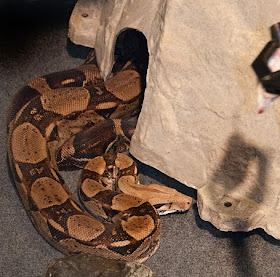
If you visit the boa constrictor and corn snake cages at Pacific Science Center, you will notice a blank area on each animal’s sign, where we write in their next feeding time. When the time approaches, we inevitably attract some loyal fans, as well as new guests eager to see what will happen. This article will try to give you a sense of what you might expect to see and learn at a snake feeding.
Warning – This following article contains a graphic descriptions of eating whole rats!
 The first thing most people notice is how infrequently the snakes eat. Our boa constrictors eat once a week and our corn snakes eat once every 2 weeks. In fact, they could go much longer between meals and occasionally a perfectly healthy snake will refuse food for several feedings in a row. However, we generally see refusal of food as a warning of other possible problems.
The first thing most people notice is how infrequently the snakes eat. Our boa constrictors eat once a week and our corn snakes eat once every 2 weeks. In fact, they could go much longer between meals and occasionally a perfectly healthy snake will refuse food for several feedings in a row. However, we generally see refusal of food as a warning of other possible problems.There are no known vegetarian snakes; all eat either some kind of animal or eggs or both. We feed our corn snakes mice and our boa constrictors mice or rats. All of our snakes are constrictors, which means they use their bodies to wrap around prey animals and suffocate them.

In captivity, it is wise to feed snakes a prey that has already been killed. Live prey can fight back and injure the snake, sometimes quite badly. Or if the snake is not hungry, the caretaker can be injured while taking out an uneaten –and angry – prey animal.
Note: We do not kill the rats and mice that we offer our snakes. They are shipped to us frozen, after being humanely euthanized.

A snake that has been fed killed prey her entire life may still strike at her food, as it is instinctive for them. This is scary. The snake slams into the food with her mouth open, seizing it and holding it while she constricts. It can take up to several minutes before she relaxes her hold. If our Animal Care staff seems jittery during feeding, it may be because it is very hard not to have a reflexive reaction when this happens.

Because of their unique anatomy, snakes swallow their prey whole. They usually start at the nose of their prey, which allows for a more streamlined swallowing of limbs than starting at the other end. Snake jaws have a unique ability to separate to allow them to open wide enough. They can continue to breathe while swallowing thanks to the placement of the epiglottis on the lower part of the mouth. The snake’s teeth are too pointed and delicate for chewing, but their backward curve helps them to push the food backward. Snakes surround their food with a thick mucous as they swallow. This helps protect their throats from being abraded by they hair and claws of their victim.

Once the snake finishes eating, we give them at least three days off to digest. They are not scheduled for demonstrations and we handle them only when they need cleaning or medical attention. Swallowing food whole is hard work and they need plenty of time to rest afterwards.

If you’d like to see a snake feeding live and in person, come visit us at Pacific Science Center. Snake feedings are generally scheduled for Saturday, Sunday, and Wednesday afternoons. But please remember these are live animals and we can’t always guarantee that they will eat as scheduled.
No comments:
Post a Comment